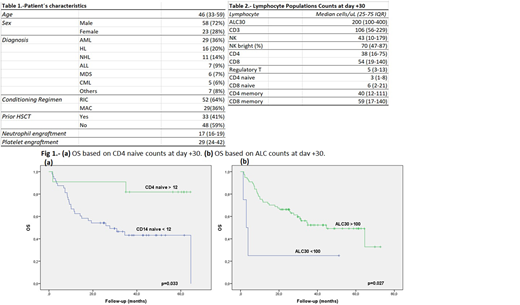Abstract
Introduction:
Immune reconstitution (IR) has a significant impact in HSCT outcome with a role against opportunistic infections and in disease control. In the setting of unmanipulated haploidentical transplantation (Haplo-HSCT), some groups have identified the absolute leukocyte count on day +30 (ALC30) as an independent prognostic factor in terms of overall survival (OS), disease free survival (DFS) and infection related mortality (IM).
The aim of this study was to evaluate the impact of early IR on different HSCT outcomes in patients who underwent Haplo-HSCT with postransplant cyclophosphamide (PTCy) at our institution.
Patients and methods:
Eighty-eight patients received a Haplo-HSCT from 2011 to 2016. Thirty-six percent of the patients received myeloablative conditioning regimen and 64% received reduced intensity regimen. Graft-versus-host disease (GVHD) prophylaxis was based on PTCy, cyclosporine and mycophenolate mofetil. Early IR was assessed through the analysis of different lymphocyte subpopulations at days +30 and +90 after transplantation, including ALC30 (cellular analyzer DXH, Beckman Coulter®); CD3+ lymphocyte count and their different subpopulations (CD4+ and CD8+ lymphocytes, naive and memory T cells) and NK cells count. Lymphocytes subpopulations were determined by multiparametric flow cytometry (FC500 and Navios, Beckman Coulter®). ROC curves were used to determine the optimal cut-off values for each of the studied variables.
Results:
Eighty-one patients were studied, excluding 7 who died before day +30. Median follow-up was 26 months (10-43). Patient´s characteristics are shown in Table 1.
CMV reactivation was documented in 76% (62) of the patients, 4% (3) developed a proven invasive fungal infection, and 31% (25) presented hemorrhagic cystitis. Median OS and DFS were 26 months (10-43) and 24 months (9-39), respectively. IM rate and NRM rate were 10% and 24%, respectively, at the end of follow up.
Median lymphocyte populations counts at day +30 are shown in Table2.
ALC30 below 100 cells/uL (p= 0.027) and CD4+ naïve lymphocytes below 12 cells/uL (p=0.033) (both corresponding to the 25 percentile) were associated with lower OS compared to patients with higher counts at day +30 (Figure 1).
Patients with ALC30 lower than 300 cells/uL (p=0.026) showed significantly higher NRM; CD8+ count lower than 20 cells/uL (p=0.022) also showed higher NRM.
NK cells counts at day +30 lower than 14 cells/uL (p=0.014), near to percentile 25, predicted higher IM (62.5% vs 37.5%).
We did not identify any lymphocyte subpopulation that could predict DFS. Patients with acute GVHD grades II-IV showed values of ALC30 lower than 200 cells/uL (p=0.051), although non-statistically significant. No relationship was found between lymphocytes subpopulations at day +90 and HaploSCT outcomes.
Conclusions:
Our study supports the prognostic significance of early IR after unmanipulated haploidentical transplantation with PTCy, as previously described by other groups. ALC30, CD4+ naïve lymphocytes, and CD8+ lymphocyte count at day +30 may be good early predictors for OS and NRM in this setting. On the other hand, low NK cells counts (lower than percentile 25) predicted higher IM. Patients with very low lymphocyte counts should be monitored closely as they are at high risk for infectious complications, NRM and OS.
No relevant conflicts of interest to declare.
Author notes
Asterisk with author names denotes non-ASH members.


